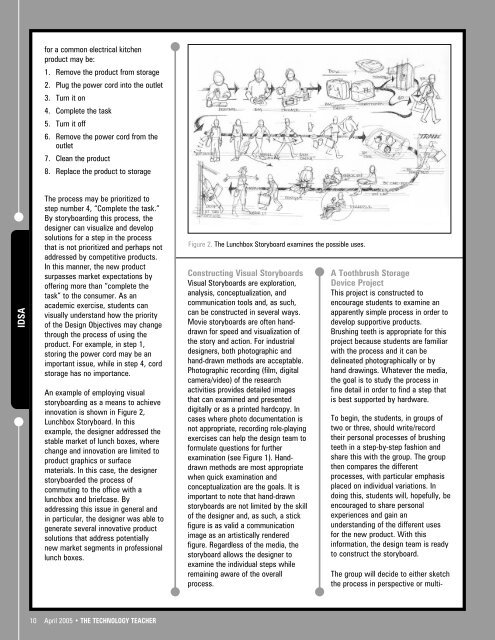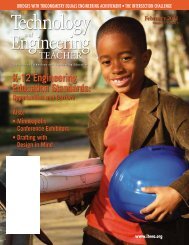Teaching Elements and Principles of Bridge Design - International ...
Teaching Elements and Principles of Bridge Design - International ...
Teaching Elements and Principles of Bridge Design - International ...
Create successful ePaper yourself
Turn your PDF publications into a flip-book with our unique Google optimized e-Paper software.
for a common electrical kitchen<br />
product may be:<br />
1. Remove the product from storage<br />
2. Plug the power cord into the outlet<br />
3. Turn it on<br />
4. Complete the task<br />
5. Turn it <strong>of</strong>f<br />
6. Remove the power cord from the<br />
outlet<br />
7. Clean the product<br />
8. Replace the product to storage<br />
IDSA<br />
The process may be prioritized to<br />
step number 4, “Complete the task.”<br />
By storyboarding this process, the<br />
designer can visualize <strong>and</strong> develop<br />
solutions for a step in the process<br />
that is not prioritized <strong>and</strong> perhaps not<br />
addressed by competitive products.<br />
In this manner, the new product<br />
surpasses market expectations by<br />
<strong>of</strong>fering more than “complete the<br />
task” to the consumer. As an<br />
academic exercise, students can<br />
visually underst<strong>and</strong> how the priority<br />
<strong>of</strong> the <strong>Design</strong> Objectives may change<br />
through the process <strong>of</strong> using the<br />
product. For example, in step 1,<br />
storing the power cord may be an<br />
important issue, while in step 4, cord<br />
storage has no importance.<br />
An example <strong>of</strong> employing visual<br />
storyboarding as a means to achieve<br />
innovation is shown in Figure 2,<br />
Lunchbox Storyboard. In this<br />
example, the designer addressed the<br />
stable market <strong>of</strong> lunch boxes, where<br />
change <strong>and</strong> innovation are limited to<br />
product graphics or surface<br />
materials. In this case, the designer<br />
storyboarded the process <strong>of</strong><br />
commuting to the <strong>of</strong>fice with a<br />
lunchbox <strong>and</strong> briefcase. By<br />
addressing this issue in general <strong>and</strong><br />
in particular, the designer was able to<br />
generate several innovative product<br />
solutions that address potentially<br />
new market segments in pr<strong>of</strong>essional<br />
lunch boxes.<br />
Figure 2. The Lunchbox Storyboard examines the possible uses.<br />
Constructing Visual Storyboards<br />
Visual Storyboards are exploration,<br />
analysis, conceptualization, <strong>and</strong><br />
communication tools <strong>and</strong>, as such,<br />
can be constructed in several ways.<br />
Movie storyboards are <strong>of</strong>ten h<strong>and</strong>drawn<br />
for speed <strong>and</strong> visualization <strong>of</strong><br />
the story <strong>and</strong> action. For industrial<br />
designers, both photographic <strong>and</strong><br />
h<strong>and</strong>-drawn methods are acceptable.<br />
Photographic recording (film, digital<br />
camera/video) <strong>of</strong> the research<br />
activities provides detailed images<br />
that can examined <strong>and</strong> presented<br />
digitally or as a printed hardcopy. In<br />
cases where photo documentation is<br />
not appropriate, recording role-playing<br />
exercises can help the design team to<br />
formulate questions for further<br />
examination (see Figure 1). H<strong>and</strong>drawn<br />
methods are most appropriate<br />
when quick examination <strong>and</strong><br />
conceptualization are the goals. It is<br />
important to note that h<strong>and</strong>-drawn<br />
storyboards are not limited by the skill<br />
<strong>of</strong> the designer <strong>and</strong>, as such, a stick<br />
figure is as valid a communication<br />
image as an artistically rendered<br />
figure. Regardless <strong>of</strong> the media, the<br />
storyboard allows the designer to<br />
examine the individual steps while<br />
remaining aware <strong>of</strong> the overall<br />
process.<br />
A Toothbrush Storage<br />
Device Project<br />
This project is constructed to<br />
encourage students to examine an<br />
apparently simple process in order to<br />
develop supportive products.<br />
Brushing teeth is appropriate for this<br />
project because students are familiar<br />
with the process <strong>and</strong> it can be<br />
delineated photographically or by<br />
h<strong>and</strong> drawings. Whatever the media,<br />
the goal is to study the process in<br />
fine detail in order to find a step that<br />
is best supported by hardware.<br />
To begin, the students, in groups <strong>of</strong><br />
two or three, should write/record<br />
their personal processes <strong>of</strong> brushing<br />
teeth in a step-by-step fashion <strong>and</strong><br />
share this with the group. The group<br />
then compares the different<br />
processes, with particular emphasis<br />
placed on individual variations. In<br />
doing this, students will, hopefully, be<br />
encouraged to share personal<br />
experiences <strong>and</strong> gain an<br />
underst<strong>and</strong>ing <strong>of</strong> the different uses<br />
for the new product. With this<br />
information, the design team is ready<br />
to construct the storyboard.<br />
The group will decide to either sketch<br />
the process in perspective or multi-<br />
10 April 2005 • THE TECHNOLOGY TEACHER
















